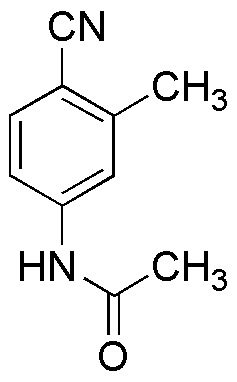4-Acetamido-2-methylbenzonitrile is widely utilized in research focused on:
- Pharmaceutical Development: This compound serves as an intermediate in the synthesis of various pharmaceuticals, particularly in the development of analgesics and anti-inflammatory drugs.
- Organic Synthesis: It is employed in organic chemistry for creating complex molecules, enhancing the efficiency of reactions due to its unique functional groups.
- Material Science: Used in the formulation of polymers and resins, it contributes to the development of materials with improved thermal stability and mechanical properties.
- Biochemical Research: This compound is valuable in studies related to enzyme inhibition and receptor binding, aiding researchers in understanding biological mechanisms.
- Analytical Chemistry: It acts as a standard reference material in chromatographic techniques, helping ensure accuracy in the quantification of similar compounds.
General Information
Properties
Safety and Regulations
Applications
4-Acetamido-2-methylbenzonitrile is widely utilized in research focused on:
- Pharmaceutical Development: This compound serves as an intermediate in the synthesis of various pharmaceuticals, particularly in the development of analgesics and anti-inflammatory drugs.
- Organic Synthesis: It is employed in organic chemistry for creating complex molecules, enhancing the efficiency of reactions due to its unique functional groups.
- Material Science: Used in the formulation of polymers and resins, it contributes to the development of materials with improved thermal stability and mechanical properties.
- Biochemical Research: This compound is valuable in studies related to enzyme inhibition and receptor binding, aiding researchers in understanding biological mechanisms.
- Analytical Chemistry: It acts as a standard reference material in chromatographic techniques, helping ensure accuracy in the quantification of similar compounds.
Documents
Safety Data Sheets (SDS)
The SDS provides comprehensive safety information on handling, storage, and disposal of the product.
Product Specification (PS)
The PS provides a comprehensive breakdown of the product’s properties, including chemical composition, physical state, purity, and storage requirements. It also details acceptable quality ranges and the product's intended applications.
Certificates of Analysis (COA)
Search for Certificates of Analysis (COA) by entering the products Lot Number. Lot and Batch Numbers can be found on a product’s label following the words ‘Lot’ or ‘Batch’.
*Catalog Number
*Lot Number
Certificates Of Origin (COO)
This COO confirms the country where the product was manufactured, and also details the materials and components used in it and whether it is derived from natural, synthetic, or other specific sources. This certificate may be required for customs, trade, and regulatory compliance.
*Catalog Number
*Lot Number
Safety Data Sheets (SDS)
The SDS provides comprehensive safety information on handling, storage, and disposal of the product.
DownloadProduct Specification (PS)
The PS provides a comprehensive breakdown of the product’s properties, including chemical composition, physical state, purity, and storage requirements. It also details acceptable quality ranges and the product's intended applications.
DownloadCertificates of Analysis (COA)
Search for Certificates of Analysis (COA) by entering the products Lot Number. Lot and Batch Numbers can be found on a product’s label following the words ‘Lot’ or ‘Batch’.
*Catalog Number
*Lot Number
Certificates Of Origin (COO)
This COO confirms the country where the product was manufactured, and also details the materials and components used in it and whether it is derived from natural, synthetic, or other specific sources. This certificate may be required for customs, trade, and regulatory compliance.


